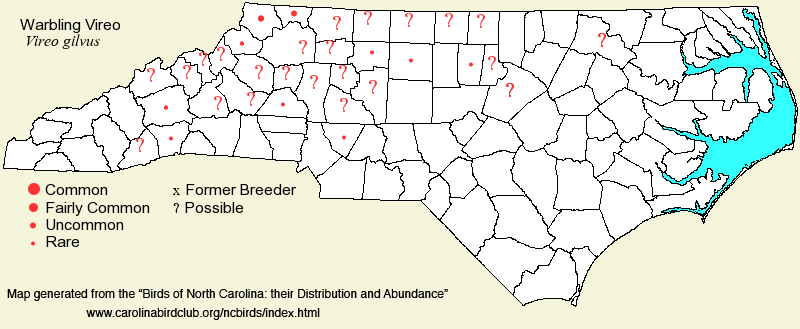 |  |
|
Warbling Vireo - Vireo gilvus VIREONIDAE Members: | Search Common: Search Scientific: |
|
|
|||||||
| General Comments | The Warbling Vireo, along with the Red-eyed Vireo, has the most extensive breeding range of any vireo in North America. It breeds from coast to coast, though North Carolina lies along the southeastern edge of the range. As with most other vireos, it winters completely south of the United States. It has an unusual migration route in spring and fall: despite nesting in northern VA and northeast to the Canadian Maritimes, in migration it essentially stays west of the state, migrating around the western end of the Gulf of Mexico rather than over it. It is thus a "once-a-decade" find for most observers east of the mountains, during migration. Warblings nest mostly in our mountain valleys, usually in tall groves and riverside hardwoods, such as along the New River and forks, and the French Broad River. Away from the mountains, a few pairs nest in similar hardwood groves, mostly near water. | ||||||
| Breeding Status | Breeder | ||||||
| NC BRC List | Definitive | ||||||
| State Status | SR | ||||||
| U.S. Status | |||||||
| State Rank | S2B | ||||||
| Global Rank | G5 | ||||||
| Coastal Plain | Transient, and possible accidental breeder. Very rare in both spring and fall. Records are increasing in recent years, though this might be due to more birding effort. From mid-Apr to late May (mostly in early to mid-May) and early Sep to mid-Oct; accidental in winter. A few birds singing on territory have appeared sporadically since 1986 at several sites near the Roanoke River in Halifax; however, no conclusive nesting has been found. A winter report of one at Roanoke Island in Dec 2000 - Jan 2001* [Chat 66:4 link] is remarkable; details were provided to the NC BRC. Another was seen in Point Harbor (Currituck) on the very late date of 13 Dec 2017 [Chat 82:71 link]. One was photographed at Pettigrew SP (Washington) on 10 Dec 2022 [Chat 87:41 link]. There is another unusual report of three birds in Wilmington on 25 Mar 1959, which was likely an incorrect identification -- out of range, a month early, and three birds is simply implausible. Peak counts: a remarkable 4, assuming all correct and different, Nags Head Woods (Dare), 15 Sep 2022; 2 on several dates. | ||||||
| Piedmont | Transient (mainly in spring), and scarce summer resident. In spring, rare in the western half, and very rare in the eastern half; in fall, casual across the province. In summer, very rare and inexplicably local (habitat is widespread), with recent nesting records from Cabarrus, Forsyth, Orange, and Wake [Chat 68:122 link], [Chat 73:124-25 link], [Chat 76:112 link]. Three singing males were found in Catawba in mid-May 2010, suggestive of nesting; records at this site have continued into 2013. Recent summer records from Guilford, where presumed to nest; and a pair suspected of nesting in northwestern Alamance (2014). As many as two singing birds were at Raleigh in the latter part of May 2020, joined by a third non-singing bird from 20-30 June -- suggestive of nesting; and similar numbers returned to this site in 2021, still without conclusive nesting evidence. Primarily late Apr to mid-May, and mid-Sep to early Oct (only 5 fall reports). Peak counts: | ||||||
| Mountains | Summer resident and transient. Uncommon in summer in the New River area of Ashe and Alleghany; rare and very local farther south in valleys, to the French Broad River (Buncombe and Henderson). Otherwise, a rare transient, at low elevations (below 3,000 feet). Mainly late Apr to late Sep, with migrants mainly in the first half of May, and the middle of Sep. Peak counts: | ||||||
| Finding Tips |
Though a scarce bird in the state, driving roads that parallel or cross the South Fork New River, within a few miles of the confluence with the North Fork, as well as doing the same along the New below the confluence, should produce a few birds in summer. *** | ||||||
| Attribution | LeGrand[2023-05-19], LeGrand[2023-03-26], LeGrand[2023-03-20] | ||||||
| NC Map Map depicts all counties with a report (transient or resident) for the species. | Click on county for list of all known species. |
| NC Breeding Season Map Map depicts assumed breeding season abundance for the species. |  |